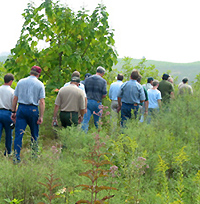UK Mine Reforestation Project is Focus of Industry Interest
UK Mine Reforestation Project is Focus of Industry Interest

On several plots of land once used for surface mining in eastern Kentucky, visitors will now see healthy trees growing. They’ll also see University of Kentucky researchers and students studying these sites to gain valuable information about soil types, water quality and land reclamation.
This reforestation project is drawing multi-state attention from several agencies and universities.
“We’ve got representatives here from the Office of Surface Mining, U.S. Fish and Wildlife, the Kentucky Department of Natural Resources, the University of Tennessee and several other groups wanting to see what we’ve accomplished here,” said Don Graves, forestry department chair in UK’s College of Agriculture, during a recent tour of the research site located at Starfire Mine near Hazard.
The research is a joint venture between UK’s departments of Forestry, Mining Engineering, and Biosystems and Agricultural Engineering. The project is funded by U.S. Forest Service and U.S. Department of Energy grants, earmarked through the efforts of U.S. Senator Mitch McConnell and U.S. Congressman Hal Rogers.
“Their diligence made this research happen, and the results indicate some real potential for this part of the state,” said Bill Schweri, UK director of federal relations and sponsored program development.
Trees were first planted at the site in 1996 to determine the effects of mine reclamation and compaction alleviation methods on growth. Soil compaction often is cited as a limiting factor in tree growth and survival. The goal was to develop tools to evaluate reclamation options for improved mine planning.
Reclamation methods in the study included non-compacted and compacted, and various types of compaction alleviation. Today, instead of the grassed areas that existed seven years ago, some plots are filled with white pine, black walnut, yellow poplar, red oak, royal paulownia and white ash. Researchers, in effect, are beginning to recreate the Appalachian forest that existed prior to mining. They’re also establishing high-value tree species that could improve the region’s long-term economic potential.
“It’s an eye-opener to see the growth potential of using a different method in creating these sites, and I think this is exciting for eastern Kentucky,” said Hank List, secretary of the Kentucky’s Natural Resources and Environmental Protection Cabinet, who participated in the tour.
Also on the tour were faculty members with the University of Tennessee’s Institute of Agriculture. Tennessee has mining operations similar to Kentucky’s, and UT’s forestry educators want to learn more about UK’s research.
“The University of Tennessee and the University of Kentucky have a rich tradition of partnerships in many areas, and certainly forestry in the two states is similar and we learn from each other,” said George Hopper, professor and head of UT’s department of forestry, wildlife and fisheries. “We wanted to see these sites so we could add to our own idea generation and thinking in terms of what direction we might go with our program.”
One of the unique aspects of the research is that, in some plots, trees are growing faster than they do in their own native sites.
“They’re growing faster because they have more area to spread their roots down than they’ve had before,” said Graves. “If you have a tree up on one of these mountain tops it may typically have only a foot or two of soil to grow in, but we’re giving the tree six or eight or 10 feet to grow in.”
Graves said in addition to tree growth, researchers also are using the reclaimed mining sites to study the carbon sequestration abilities of trees, forest hydrology, and wildlife habitat.
“This research is long term, and you don’t get all the answers in seven years,” he said. “But these sites will serve as outdoor classrooms for kids so they can come and see what can happen if an area is treated properly so that it grows trees back for future generations.”